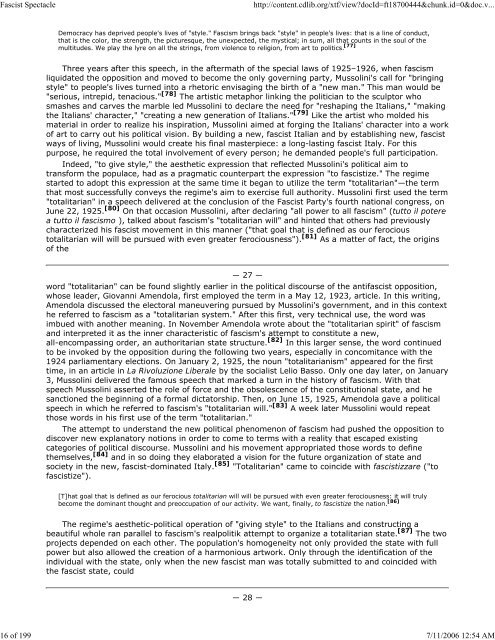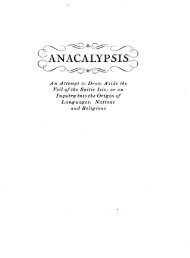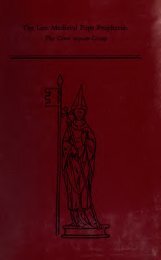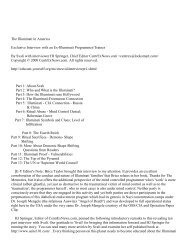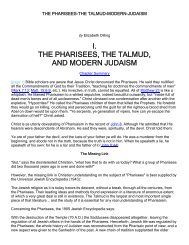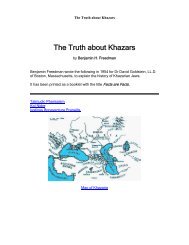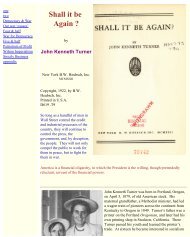You also want an ePaper? Increase the reach of your titles
YUMPU automatically turns print PDFs into web optimized ePapers that Google loves.
<strong>Fascist</strong> <strong>Spectacle</strong> http://content.cdlib.org/xtf/view?docId=ft18700444&chunk.id=0&doc.v...<br />
Democracy has deprived people's lives of "style." Fascism brings back "style" in people's lives: that is a line of conduct,<br />
that is the color, the strength, the picturesque, the unexpected, the mystical; in sum, all that counts in the soul of the<br />
multitudes. We play the lyre on all the strings, from violence to religion, from art to politics. [77]<br />
Three years after this speech, in the aftermath of the special laws of 1925–1926, when fascism<br />
liquidated the opposition and moved to become the only governing party, Mussolini's call for "bringing<br />
style" to people's lives turned into a rhetoric envisaging the birth of a "new man." This man would be<br />
"serious, intrepid, tenacious." [78] The artistic metaphor linking the politician to the sculptor who<br />
smashes and carves the marble led Mussolini to declare the need for "reshaping the Italians," "making<br />
the Italians' character," "creating a new generation of Italians." [79] Like the artist who molded his<br />
material in order to realize his inspiration, Mussolini aimed at forging the Italians' character into a work<br />
of art to carry out his political vision. By building a new, fascist Italian and by establishing new, fascist<br />
ways of living, Mussolini would create his final masterpiece: a long-lasting fascist Italy. For this<br />
purpose, he required the total involvement of every person; he demanded people's full participation.<br />
Indeed, "to give style," the aesthetic expression that reflected Mussolini's political aim to<br />
transform the populace, had as a pragmatic counterpart the expression "to fascistize." The regime<br />
started to adopt this expression at the same time it began to utilize the term "totalitarian"—the term<br />
that most successfully conveys the regime's aim to exercise full authority. Mussolini first used the term<br />
"totalitarian" in a speech delivered at the conclusion of the <strong>Fascist</strong> Party's fourth national congress, on<br />
June 22, 1925. [80] On that occasion Mussolini, after declaring "all power to all fascism" (tutto il potere<br />
a tutto il fascismo ), talked about fascism's "totalitarian will" and hinted that others had previously<br />
characterized his fascist movement in this manner ("that goal that is defined as our ferocious<br />
totalitarian will will be pursued with even greater ferociousness"). [81] As a matter of fact, the origins<br />
of the<br />
― 27 ―<br />
word "totalitarian" can be found slightly earlier in the political discourse of the antifascist opposition,<br />
whose leader, Giovanni Amendola, first employed the term in a May 12, 1923, article. In this writing,<br />
Amendola discussed the electoral maneuvering pursued by Mussolini's government, and in this context<br />
he referred to fascism as a "totalitarian system." After this first, very technical use, the word was<br />
imbued with another meaning. In November Amendola wrote about the "totalitarian spirit" of fascism<br />
and interpreted it as the inner characteristic of fascism's attempt to constitute a new,<br />
all-encompassing order, an authoritarian state structure. [82] In this larger sense, the word continued<br />
to be invoked by the opposition during the following two years, especially in concomitance with the<br />
1924 parliamentary elections. On January 2, 1925, the noun "totalitarianism" appeared for the first<br />
time, in an article in La Rivoluzione Liberale by the socialist Lelio Basso. Only one day later, on January<br />
3, Mussolini delivered the famous speech that marked a turn in the history of fascism. With that<br />
speech Mussolini asserted the role of force and the obsolescence of the constitutional state, and he<br />
sanctioned the beginning of a formal dictatorship. Then, on June 15, 1925, Amendola gave a political<br />
speech in which he referred to fascism's "totalitarian will." [83] A week later Mussolini would repeat<br />
those words in his first use of the term "totalitarian."<br />
The attempt to understand the new political phenomenon of fascism had pushed the opposition to<br />
discover new explanatory notions in order to come to terms with a reality that escaped existing<br />
categories of political discourse. Mussolini and his movement appropriated those words to define<br />
themselves, [84] and in so doing they elaborated a vision for the future organization of state and<br />
society in the new, fascist-dominated Italy. [85] "Totalitarian" came to coincide with fascistizzare ("to<br />
fascistize").<br />
[T]hat goal that is defined as our ferocious totalitarian will will be pursued with even greater ferociousness: it will truly<br />
become the dominant thought and preoccupation of our activity. We want, finally, to fascistize the nation. [86]<br />
The regime's aesthetic-political operation of "giving style" to the Italians and constructing a<br />
beautiful whole ran parallel to fascism's realpolitik attempt to organize a totalitarian state. [87] The two<br />
projects depended on each other. The population's homogeneity not only provided the state with full<br />
power but also allowed the creation of a harmonious artwork. Only through the identification of the<br />
individual with the state, only when the new fascist man was totally submitted to and coincided with<br />
the fascist state, could<br />
― 28 ―<br />
16 of 199 7/11/2006 12:54 AM


